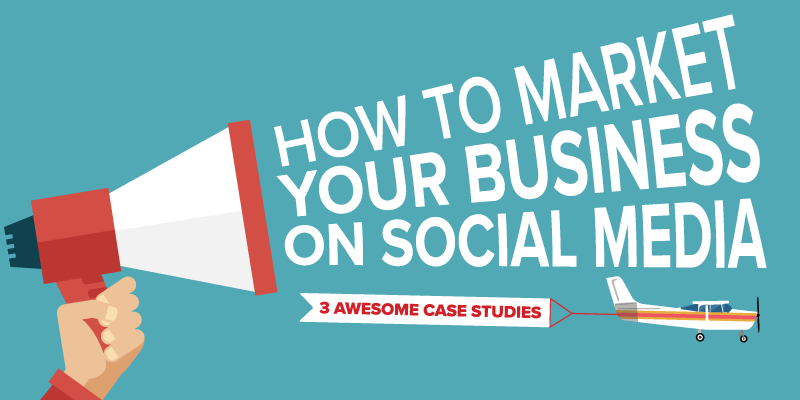
When it comes to the issue of social media marketing, businesses are beyond asking, Should we? The question is now, How do we? Plenty of experts have tried to answer this question with a social media marketing guide.
While these have their place, there’s plenty you can learn just by looking at what other people have done. Facebook, Twitter, and Instagram have all helped catapult certain businesses in ways that traditional marketing could not; savvy business owners have been able to leverage these platforms to connect more authentically with their customers, creating loyal followings.
To see what this looks like in action, let’s look at success stories from each of the Big Three social platforms: Facebook, Twitter, and Instagram.
1. Facebook Success: Mark Dawson, Author
As far as small businesses go, “Self-Published Fiction Author” has to be the smallest. Mark Dawson handles every aspect of his business, from writing the novels he sells, to publishing the novels he sells, to marketing the novels he sells, to—of course—selling the novels he sells. And he sells a lot of them. But before Dawson was a wildly successful writer, he was…well, a successful writer.

Mark Dawson, and his laundry. This is not your average head shot.
By that I mean that Dawson had gone the traditional fiction writer’s route to success, landing a book deal, getting a decent advance, and then watching two of his creations get published and stocked on the shelves of UK bookstores. For many writers, just getting published can feel like you’ve made it—and that’s how Dawson felt. Until, that is, no one bought his books. The frustrating thing for him was, he could hardly fault the book-buying public for ignoring him. His publishers did nothing to market or promote the books, and Dawson walked away from writing feeling let down, as though his books weren’t even given the chance to fail on their own. It wasn’t until Amazon introduced the Kindle Direct Publishing platform that he decided to give his first love another go.
This time, he could handle the marketing and promotion all on his own, and developed and tweaked his own system with the release of each new work. His first self-published book, 2012’s The Black Mile, didn’t do much sales-wise, but the experience taught him he needed to market himself better. That’s when Dawson began actively promoting himself using the tools in his budget—email and social media. Three years later, he was earning $450,000 a year and celebrating his 1,000,000th download from Amazon.
How’d he do it?
Hook them in with a freebie
First things first, he wrote a lot of books. Like, a lot of books, and in a very short time. His John Milton series of action-thriller novels is about to see its 10th release; the Beatrix Rose series stands at six. These make up the bulk of the 20 works Dawson has written and published Since 2014. His prolific output helped his marketing greatly.
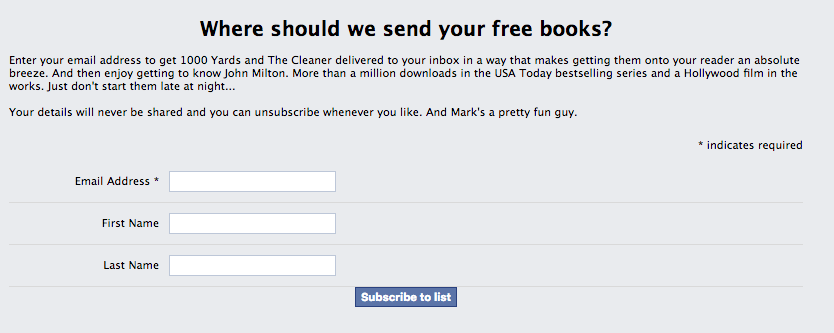
With Facebook and MailChimp, Dawson runs very tactical promotional campaigns. Using Facebook for outreach—through paid ads and organic posts on his Page—he’d offer the first two installments of his John Milton series, free, to anyone who subscribed to his newsletter. His books are the kind of fast-paced action-thriller novels that avid readers can soak up in a day at the beach. But they are also character driven, the kinds of characters who reveal themselves over the course of several novels; by giving away the beginning of the series, Dawson bet that people would pay for the rest. Which is exactly what happened.
In January 2014, as Dawson began to understand what he needed to do, his Facebook Page had 1,000 followers. He started writing at a furious pace, and would complete 6 novels and 2 novellas by the end of the year. He’d also amass an additional 14,000 followers while selling 10,000 books a month.
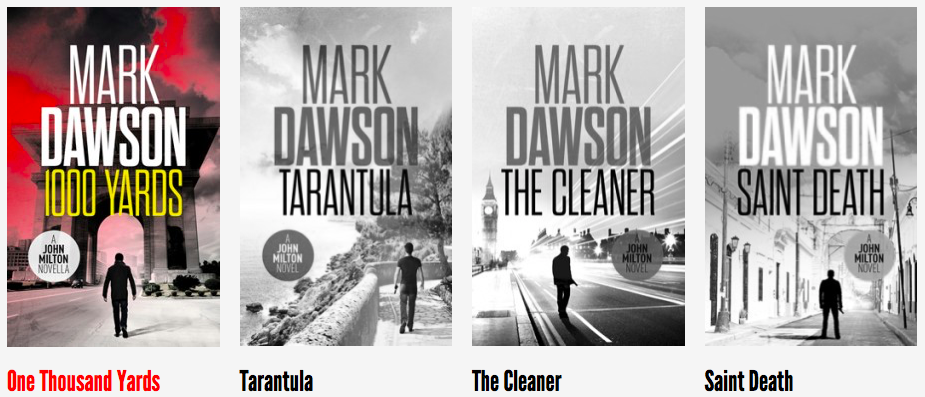
The first of six rows of novels listed on Dawson’s website.
Target people who like your competitors
Much has been made over the way Dawson began using Facebook Ads in highly targeted ways. In an interview that appears on the Reedsy blog, Dawson explained how he was able to convert so many people who’d never heard of him:
My books are often compared in their genre to Lee Child, so one of the things that I do on Facebook is serve ads just to people who know or like Lee Child — fans of his fan page, fans of the Jack Reacher fan page, etc.
Notice how he didn’t just go generic, and start serving ads out to people who had Goodreads accounts, or list “reading” as a Like. He definitely would have reached more people that way—millions more, probably—but with no guarantee of being relevant to the user. Getting this precise in his targeting also allowed for a more cohesive user experience. The ad itself was written to appeal to those Jack Reacher fans he targeted, and those who clicked through to sign up for the email list were presented with a landing page optimised to convert that specific audience. Dawson has other, no less precise, ways of targeting users to serve ads with direct links to buy his books. But he didn’t start doing any of this until 2015, after he’d already exploded into a bona fide success.
In 2014, he simply maintained an active and personal presence on Facebook. His posts are about a 50/50 mix of promotion and interaction. The promotional posts are clearly still working—he went from 22,106 followers to 22,332 followers in the 30 or so minutes I spent poking around his Facebook page.

Tellingly, though, it’s the non-promotional posts that get the most engagement. He’ll often post inspirational or witty quotes from other authors that can be hit or miss with the audience. But when Dawson shows up and is just being himself, the page gets active.
A frequent topic of discussion on his page is, simply, “What are you all doing this weekend?” This is followed by friendly chatting in the comments as if this were a group of people who’d known each other forever. And Dawson responds to just about everything—if something merits an actual response, it gets one. If there’s nothing more to add, Dawson will at least check “Like” on a user’s comment—every single time, for every single post.
Use Personality to Breed Loyalty
The most popular post he’s made in the last few weeks was a Facebook Live video tour of his new office—essentially an empty room with white walls, a desk, and a computer in the corner. 117 different comments and reactions were logged in the 5 minutes his video lasted.
If you send a private message to him, you’ll get some kind of response. According to FB, he “typically replies within an hour.”
Ask him for a question about his craft, and he’ll answer.
Tell him you love his books, and he will always say thank you.
There seems to be literally nothing that this man won’t respond to, and that breeds loyalty in his fan base. That’s important: you may have noticed his rate of acquiring new followers has slowed considerably since his breakout year. He jumped from 1K to 15K during 2014, but has only increased that number by 6K in the two years since. His sales haven’t slowed down, though; with three new books out this year and another due by Christmas, he’s still selling hundreds of books per day on the Kindle store.
What Any Business Can Learn From All This
Giveaways Give You an Edge
Mark Dawson, as a financially successful self-published author, occupies a tiny niche of an extreme subset of a very small percentage of retail operations in the world. His business might be very specific, but his social media marketing tactics aren’t. In fact, I’d go so far as to say that self-published authors are the least likely to benefit from the wisdom of his experiences, simply because most authors don’t have the superhuman capacity to write full-length books at the pace Mark Dawson does. Giving your book away for free isn’t exactly a customer magnet when you’ve only written one or two of them.
In retail or hospitality, though: you’ve got plenty of that item you’re selling. If you’ve got a bookstore, giving away books is done knowing you’ve got another thousand or more different titles to choose from. If you own a coffee shop, you can’t run out of your product, by definition. Handing out free coffee in exchange for signing on to a newsletter or liking a Facebook Page isn’t just doable for you: it’s advisable.
Target Ads at Your Competitor’s Customers
Likewise for Dawson’s Facebook Ad tactic of targeting users who like Jack Reacher novels, aka his competitor’s customers. If you’re a small business, there’s no shame in finding people who patronise the competition. A family owned coffee shop should absolutely be targeting their ads at people who like Starbucks. There’s nothing wrong with saying, “You like coffee? We make it, too!” Note, too, that when Dawson pays for ads, he does so with very clear goals. In his interview with Reedsy, he said this explicitly, “There are two things I use Facebook ads for: growing my mailing list and driving direct sales.” Many people make the mistake of spending on Facebook ads without a specific purpose beyond “raising awareness.” That’s an easily achievable goal—people will see your ad and become aware—but nobody ever paid the bills with awareness (except Bono).
[bctt tweet=”How to Market Your Business on Social Media – 3 Awesome Case Studies” username=”appinstitute”]
2. Instagram Success: Wedding Chicks
Weddings are big business in the United States, with the average couple spending $26,645 on their special day. That figure goes way up when adjusted for Kardashians. At $51 billion a year, it’s a very lucrative industry, which is to say that it’s also super competitive. That’s a lesson learned the hard way by the two owners of Wedding Chicks, photographer Amy Zawacki and graphic designer Jocelyn Canrinus. They each worked for years in the industry—Zawacki behind the lens at weddings while Canrinus designed invitations in advance of them. Eventually, all the long hours, emotional customers, and stiff competition had the two friends conspiring for ways to take their combined talents and knowledge in new directions.

The Wedding Chicks: Amy Zawacki, left, and Jocelyn Canrinus, not left.
In 2008, they started Wedding Chicks, a website that is essentially a hub for all things wedding and wedding-planning related. Their blog is a collection of posts designed to inspire, advise, and educate about the kinds of things people just don’t think about every day: what to look for in a dress; great locations for an engagement photo shoot; proposal stories; decoration ideas; the occasional personal essay meditating on the female experience. Wedding Chicks is also a marketplace of sorts. It’s got its own shop, offering custom printed apparel, tote bags, napkins, and other items (for party favors and the like). The website also boasts a large network of vendors, from photographers to caterers to—you get the idea. The company’s grown steadily since its inception, and social media has definitely played a role.

They’d been on Facebook almost since the beginning and in that time have amassed over 2 million followers. That’s an impressive number, but it’s their Instagram account where all the action is happening. That account’s been live since 2012, but didn’t do much with it at first. “We typically hop on any new social platforms to secure our name,” Zawacki said. They didn’t start using Instagram in earnest until 2014, and the account has exploded since then—which makes a lot of sense considering their visual backgrounds. Their current follower account is nearly 669,000 and climbing—not even half of what they have on Facebook—but the audience engagement on IG is several orders of magnitude larger. The last 5 Facebook posts, as I write this, received a total of 37 likes between them. The last 5 on Instagram? 12,356.

How’d they do it?
Instagram being Instagram, Zawacki and Canrinus make sure that their feed is always visually appealing and relevant to what their followers want. They source images from any of the scores of wedding and lifestyle photographers who populate the platform, all of whom are happy to show their work, with a photo credit, to a much larger audience. The visual appeal doesn’t stop at the individual photo, though. Looking at the Wedding Chicks’ feed in the standard three-across thumbnail arrangement is to understand that there is a unifying aesthetic to all the images. It’s a cohesive gallery of photographs, one that has the look of a singular photo album. You half expect a pair of giddy newlyweds to narrate each image at you while their parents serve you appetisers.

Achieving this kind of cohesion is no easy task—it takes skill, time, and a good deal of experience to ensure that every image is on-brand. The key is creating a consistent aesthetic that allows customers to identify with the lifestyle of the brand. If you don’t yet have those skills and need to start developing your social media image immediately, there are apps such as Instasize which make the process a great deal easier for those just getting into the game. It’s an all-in-one editor for visual content—both photo and video—with simple yet powerful tools to get you started, and includes a variety of professionally-designed filters, themes, and styles. It’s free to download on iOS and Android so monetary investment is minimal, but the level of polish and consistency it can give your content is worth way more.
Leveraging Other Tools
A satisfying aesthetic is only half the battle, though. Within that singular look has to be content that followers want to see. Zawacki and Canrinus make sure of this by using Have2Have It, a tool designed to help people sell items on Instagram. H2HI works by making use of the one place in an Instagram profile that has a clickable link: the bio. That link takes users to a webpage that lists all the items that are for sale within an IG feed. Click on the picture you saw in the feed, and it takes you to a website where you can buy it. Every click is tracked for use with advanced analytics and reporting. But the Wedding Chicks are using this tool differently: instead of selling things on Have2Have It, they’ve used their curated page to function as a mirror of their Instagram feed. Every post on Instagram links to a post on their blog, and Have2Have It is the vehicle by which they get their followers from point A to point B. Doing this not only drives website traffic, but provides them usable data about which types of posts get the biggest response, which sputter and die, and much more. They’re constantly looking at this data to identify ways to stay relevant to their audience—knowing what they have liked makes it easier to know what they will.
Capitalizing on #Hashtags

To attract new followers, they rely mainly on hashtags. Each post might contain a dozen or more of them, and they consistently research what’s trending to see if there are any slightly off-brand ones that might work. For example, their recent post showing an autumn themed place setting—complete with fancy china and silverware, stemmed glassware, and small, colorful gourds as centerpieces. In addition to the usual suspects for wedding hashtags, they added in #thanksgiving, #thanksgivingdecor, and #holidaydecor. Between staying on top of hashtag trends and leveraging their various social media presences, the Chicks haven’t really seen a need to advertise. Zawacki said, “We very rarely pay for ads, mainly because we have little time to research what would best work for us.”
Engaging with Giveaways

Finally, no social media success story would be complete without free stuff. When I’d gone to check their feed to see if they did that sort of thing, i didn’t have to scroll back more than a day: an image of tote bags from the Wedding Chicks shop, with the words “Eat Drink and Be Married” printed on them. Participation in the contest meant going to their website, picking out a favorite design, and then leaving a comment as to which one you picked. Three random entries would be picked to win. I almost entered myself just to win those tote bags and put commas on them, because these are the things that keep me up at night. But, one day and 2,625 likes later, there were 367 entries and my chances looked slim. Such is the power of free stuff.
What Any Business Can Learn From This
Give the People What They Want
The Free Stuff Strategy is mostly self-expanatory, though Zawacki cautioned that giveaways are only successful “IF you are promoting something your audience wants/likes.” Again, it’s a matter of relevance. The freebies you hand out, like the posts you’ll making to your account, need to be something of interest to your audience. That might seem self-evident, but you won’t know exactly what interests them till you get to know their preferences. If you’re just starting out on Instagram with next to nothing on your feed, you’ll be doing a lot of guesswork for the near future. If you’re already established with a sizable feed, then there’s data sitting there, waiting for you to mine it. In either case, you should be using some kind of analytics engine.
Use Analytics Software To Uncover What Works
3. Twitter Success: Curtis Kimball, The Creme Brulee Man
The more I researched Curtis Kimball, the more I felt that he might not be the best example in a piece on successful social media strategies. For one thing, his success on Twitter can’t be measured in likes and retweets. And, maybe more importantly, Kimball didn’t actually have a strategy. He came upon Twitter as a marketing tool by accident, and his success on the platform wasn’t the result of any grueling market research. Kimball’s approach to Twitter—and his business—was to create something that he would want to be a part of.

Humble beginnings.
It was with that mindset that Kimball, in March of 2009, began selling homemade creme brulees out of an awkward little cart that looked more like a magician’s prop than a food concession. He’d set up at various places around San Francisco in parks and on busy streets, without a schedule or a license to operate. Donning a chef’s hat that appeared incongruous with the rest of his street clothes, Kimball torched each sugary crust to order and quickly gained a modest following of friends and neighbors. In a place like San Francisco, creme brulee is generally the $10 dessert at the end of $100 meal—it turned out there was a big market for fancy snacks under $5
It was only three weeks into the experiment struck up a conversation with a customer he didn’t recognize. Somebody had tweeted out the location of the cart, enthusiastically recommending Kimball’s custard concoctions. Everything pretty much snowballed from there: seeing the power of Twitter as a way to let people know where he’d be, Kimball took @cremebruleecart live on March 21, 2009. By July of 2009, the account had 5,400 followers—not bad for a weekend side gig. Kimball would tweet his location and hours—sometimes a day in advance, sometimes last minute—along with the menu of flavors for the day. By July of 2010, the Twitter account stood at 12,000 followers and Kimball upgraded to a proper food cart and even got his operator’s license.
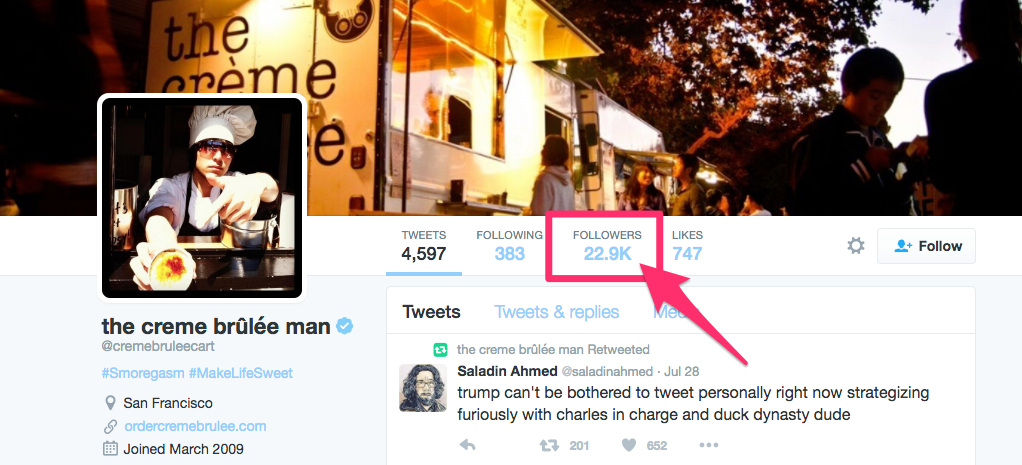
Over the ensuing years, growth was explosive. Catering became a regular part of the business. Kimball also added a full-service food truck, which roamed the streets of San Francisco’s Castro neighborhood while the cart made its rounds in the financial district. Then he opened a walk-up window in SoMa, another SF neighborhood. By July of 2012, @cremebruleecart regularly tweeted locations and menus to its more than 22,000 followers. Another cart was added. A brick-and-mortar storefront followed in 2013. By 2015, Kimball was sitting atop a gooey and delicious empire—the Creme Brulee Man had become big business. And that turned out to be too much for Kimball; he closed all his doors indefinitely and limited his brulee-ing to private catering gigs. In May, 2016, the Creme Brulee Man announced on Facebook he was selling:
I’ve had a great run, but the truth is that I was never meant to be a businessman. At least not in that sense. I like creating and building and trying things that no one has ever done before. I like working with my hands and with a small group of weird people to build a thing.”
Turned out the crust of sugar on top of every dessert he made wasn’t the only thing that was burnt. While this is a loss for the community of fans he built in his home city, it’s a win for him. He built something huge, and when it stopped being fun it was big enough that Kimball could afford to step back and figure out his next step.
How’d he do it?
Tell your followers things they need to know
I would love to say that I just had a really good idea and strategy, but Twitter has been pretty essential to my success.”
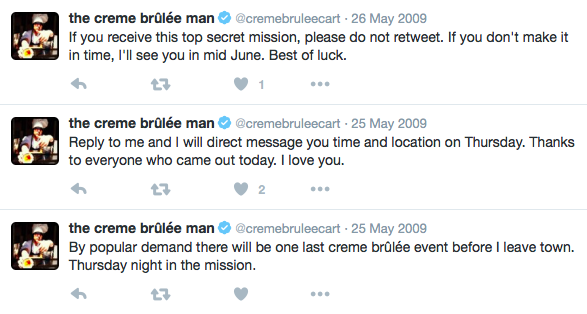
Incidentally, the above tweets were supposed to have been the last night the cart was in operation for a few weeks while Kimball went on vacation for a few weeks, which he’d only announced the day before. He must have gotten some responses from people who couldn’t make it that night, and who didn’t want to go three weeks without his creme brulee. It wasn’t long after that final, pre-vacation “Sold out” tweet that Kimball got back online.
Build a community
The “top secret mission” became a regular, if infrequent, occurrence, though it happened enough to help add to the excitement around the car. With only limited numbers of people privvy to the cart’s whereabouts, Kimball created an aura of exclusivity and belonging around his business. Again, this wasn’t something he planned as a marketing strategy. Rather, it was a natural way for him to create something that he was excited to be a part of. In an interview with SF Weekly back in his early days, Kimball explained his motivations for the way he ran his business:
The reason I’m into this is it makes people happy and brightens their day. There’s a touch of excitement to it, not like having regular hours and regular locations. It’s like an event that you’re part of rather than being a once-a-week supermarket. I don’t like feeling like the help, or like a carnie. I like to feel like a member of the community.”
When you read that, it’s easier to understand why Kimball ended up shutting it all down and putting the business up for sale. But it also becomes easier to understand the loyalty of his fans and customers. People who came to buy his desserts weren’t regarded as customers when they got there. Instead they were treated as a part of a community, like friends with a sweet-tooth whose days Kimball could make a little a better. And that kind of bond he felt spilled over into his non-brulee related tweets. When he wasn’t telling you where he’d be and what flavors he had, Kimball was tweeting nice things about other food carts and trucks, or posting pictures of customers with a quick backstory attached. Most notably, he kept it personal, broadcasting messages to thousands of people like they were part of a small circle of friends:
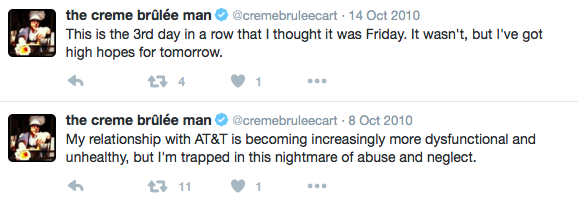
Kimball wasn’t afraid to get political, either, often tweeting his views and opinions on local, national, and global issues. Of course, sharing your left-leaning liberal views on current events with the city of San Francisco is about as controversial as attending a bankers’ convention and declaring you like money. But these are the kinds of things that put a relatable, human face on the business and very much fostered a community.
[bctt tweet=”How to Market Your Business on Social Media – 3 Awesome Case Studies” username=”appinstitute”]
What Any Business Can Learn From All This.
Kimball may not have had much of a plan or strategy entering into things, but he also had incredible instincts to make his Twitter account work for him. The @cremebruleecart account succeeded for two main reasons: it had a personality, and it fostered a sense of community (which is just a nicer word for “exclusivity,” where a business is concerned). These are things that go a long way on social media, especially Twitter.
Play to Your Platform’s Strengths
One of the Twitter’s hallmarks is the way it’s rooted in the present. The character limit on a tweet means there’s only so much information you can include. That gives Twitter, more than any other social platform, a feeling of immediacy and urgency about it. A tweet is a little slice of life at a given moment presented in a user’s feed, often without context. This focus on the Now works to a small, local business’ advantage. A large national chain can’t operate with the same kind of agility: Starbucks could never decide at the last minute that all their locations (even in a single metro area) we’re going to stay open an hour later for a members-only happy hour. And even if they could, it’d be hard to create a sense in customers that they were in on something special, that they were part of a small group of people enjoying the perks of belonging to something.
Create and Nurture a Community
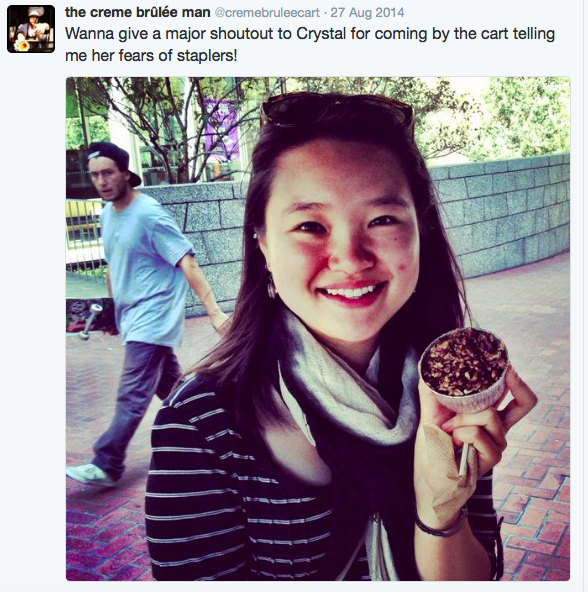 Any small business can do all these things: humorously confessional tweets, special and time-sensitive offers made only to followers, and even more exclusive events (a la Kimball’s “top secret missions”). Tweets sent out during your work day, maybe with behind-the-scenes pictures featuring the staff can demonstrate a business’ humanity. And exclusive events, like a members only happy hour in-store sale, open only to your loyal Twitter followers—and announced at the last minute—create a feeling of belonging and community among those who’ve chosen to follow you. Those who go the extra step to follow you on Twitter ought to be given special consideration, anyway. The simple fact of them having let you into their newsfeeds is enough that you shouldn’t want to betray that acceptance with spammy posts that annoy people.
Any small business can do all these things: humorously confessional tweets, special and time-sensitive offers made only to followers, and even more exclusive events (a la Kimball’s “top secret missions”). Tweets sent out during your work day, maybe with behind-the-scenes pictures featuring the staff can demonstrate a business’ humanity. And exclusive events, like a members only happy hour in-store sale, open only to your loyal Twitter followers—and announced at the last minute—create a feeling of belonging and community among those who’ve chosen to follow you. Those who go the extra step to follow you on Twitter ought to be given special consideration, anyway. The simple fact of them having let you into their newsfeeds is enough that you shouldn’t want to betray that acceptance with spammy posts that annoy people.
Do as Kimball did: create a community, the kind that you’d want to be a part of. Then participate in that community, regarding its members as friends and allies. Be personable and relatable; when you have to tweet about the business proper, keep the spotlight on customers and topical subjects: advertising 10% off everything for a day won’t be as effective as 10% off a specific item that only Twitter followers have access to. Twitter may allow you to reach thousands, if not millions, of users with each tweet, but it’s those one-on-one personal connections that need to nurtured. This is something that came naturally to the Creme Brulee Man, and by studying his instincts any small business can act off an established blueprint to success.
Think Like a Customer not a Marketer
So what’s the uncomplicated answer to the question of how to market on social media? If you look at the companies that are doing well, they’ve all got something in common: they’re likeable. It’s not that they make or sell things that make them likeable. It’s more that they’ve remembered the rules of engagement of the platform. What works for a personal profile works for a business. Dave Kerpen, CEO of social media agency Likeable (really!), breaks it down this way:
If you stop thinking like a marketer and start thinking like a customer, you’ll understand that the secret to social media is being human–being the sort of person at a cocktail party who listens attentively, tells great stories, shows interest in others, and is authentic and honest.
I’ll grant you that the words “authentic” and “honest” aren’t normally associated with something like marketing, but social media is changing that. Brands have greater reach than ever, but consumers get more control over who’s reaching them. Businesses have had to adapt as required. It’s a delicate balance when you’re trying to be relatably human and sell something, but it can and has been done.



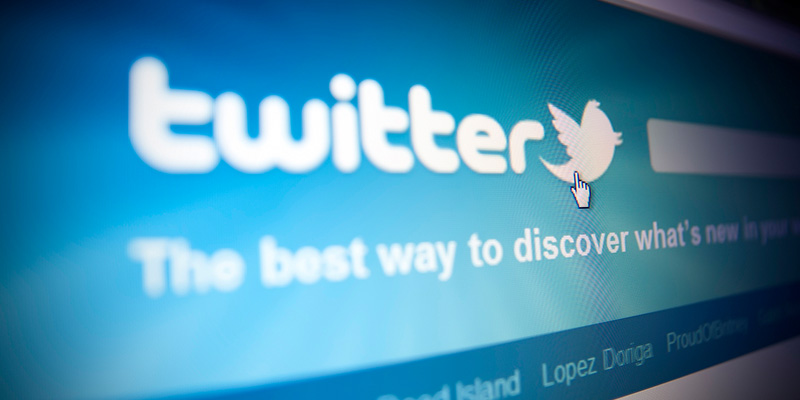
5 thoughts on “How to Market Your Business on Social Media – 3 Awesome Case Studies”